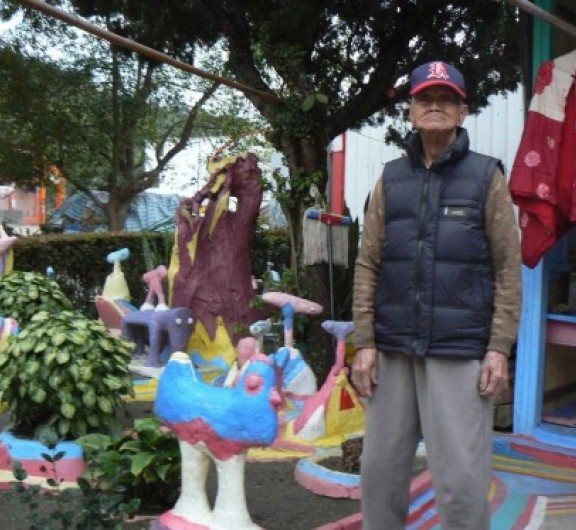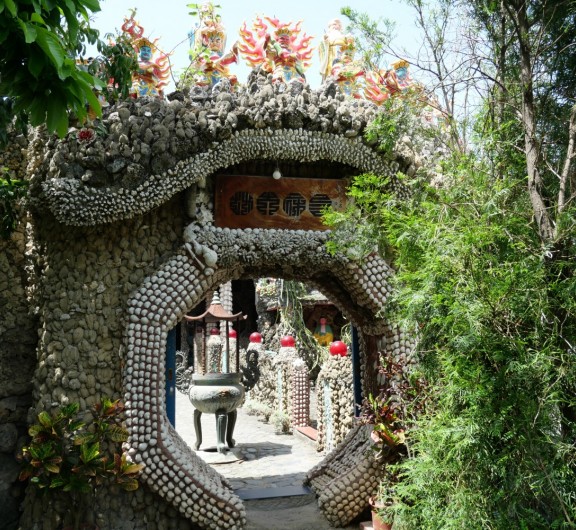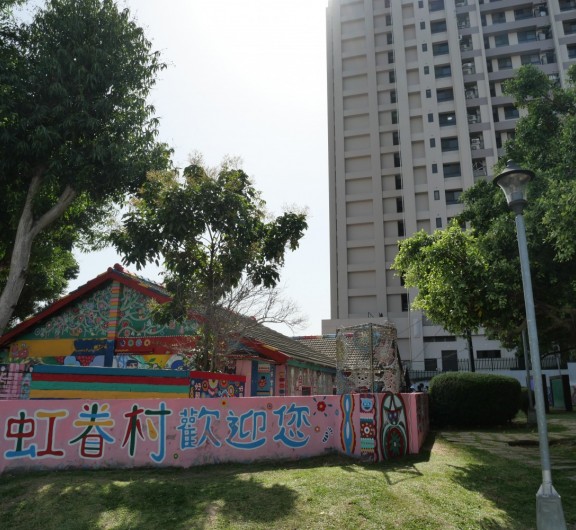The Park of the Buffalo’s EarLin Yuan (1913-1991)
About the Artist/Site
Today, Lin Yuan is internationally recognized as one of the great names of Taiwanese art brut. But if his graphic work has been the subject of several international exhibitions, his sculpted works, and particularly the monumental pieces, which are the most important, are much less known. It is, in fact, necessary to visit the Park of the Buffalo’s Ear in order to fully appreciate the importance of these works. This park, in Pu li, is located in the village closest to the mountain village in which Lin Yuan passed most of his life. It is situated more or less in the center of the island of Taiwan.
An illiterate agricultural worker originally from Wuzhi canton, Lin Yuan became a widower at a very young age. Having passed his fiftieth year, his grown children (five boys and three girls) suggested to him that he stop his laborious and solitary field labors, and instead care for their children. He agreed, and while doing so, he amused himself by creating little toys for them, all created from various recycled materials. Then, one day seeing some neighbors gathering stones from the river for some masonry work, he had the desire to try to sculpt them. From then on he tackled the rocks, using ever-larger ones for his work. Soon word about his sculptures spread, until a local magazine featured a story about this “artist-peasant.”
A wealthy banker from the village named Huang Pingsong visited Lin Yuan and, fascinated by his works, purchased the entire lot of his production. The artist, encouraged by the banker’s enthusiasm, decided to dedicate himself from then on to creative activity; subsequently, he diversified his works to include paintings and even embroideries. Sustained by his patron, as well as by various intellectuals and artists, his fame began to spread; even Jean Dubuffet’s attention was called to Lin Yuan.
In the mid-1980s, Huang Pingsong decided to acquire property in Pu li in order to install the works of his protégé and to enable him to work under more comfortable conditions. Lin Yuan therefore moved into a little house constructed for that purpose on the grounds (now inhabited by one of his sons). Today the park, which includes a small museum, is embellished with some of his largest sculptures, and it has become a small tourist attraction: after the artist’s death, a small café and a series of bungalows that people can rent to stay overnight provide support for the site.
The numerous sculptures at the park, despite the lack of resources expended to conserve them and enhance their presentation, are impressive by virtue of their huge expressive force, without unnecessary flourishes. Never could the notion of “brut” be better applied to artwork than to the work of Lin Yuan. The rough features, like the marks of the hammer or his other tools, are essential. Artifice is absent in this work; it feels convulsive, as if it had to be urgently finished in order not to waste time. Sculpture seemed to Lin Yuan to be a fight or a challenge that he enjoined again each day, as if the concern was to try to master a raw material that never ceased resisting him. The struggle was so intense that in 1988 he fell ill and had to be hospitalized. After this crisis, in order to conserve his health, he started spending more time on less physically-demanding creations, such as his embroidery and paintings.
If Lin Yuan was strongly influenced by his natal environment, which led him to represent a number of domesticated, farm, and wild animals, he was equally influenced by subjects that Chinese artists traditionally tend to avoid: love and sexuality (according to Chinese art historian Van Gulike, representations of love or sex in Chinese art are mostly expressed for didactic reasons). These two themes are very present in Lin Yuan’s work, without any didactic intent; in fact, some appear to be almost pornographic, such as the Woman with a Bad Life, who displays the most intimate parts of her anatomy. Male sexual attributes, often of significant size, are likewise very often represented in his paintings as well as in his monumental sculptures. In a country which is still very puritan, this part of his work has been interpreted as a result of his premature widower-hood. He himself never explained it, amusing himself, without doubt, by the explanations delivered on his behalf, and never ceased his efforts to represent freely inspired characters.
During the seven years that Lin Yuan stayed at the Park of the Buffalo’s Ear, he created several hundred works in all formats, all of which have been maintained to support his museum. It is available for visits by the public.
~Remy Ricordeau
Translated by Jo Farb Hernández
Contributors
Map & Site Information
Wuxinshi Industry Road, 959
tw
Latitude/Longitude: 22.9354288 / 121.2134874
Nearby Environments







Post your comment
Comments
No one has commented on this page yet.